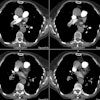Arch Surg 2001 May;136(5):505-11
Spiral computed tomography for the diagnosis of pulmonary embolism in
critically ill surgical patients: a comparison with pulmonary angiography.
Velmahos GC, Vassiliu P, Wilcox A, Hanks SE, Salim A, Harrel D, Palmer S, Demetriades D.
HYPOTHESIS: Spiral computed tomographic pulmonary angiography (CTPA) is sensitive and
specific in diagnosing pulmonary embolism (PE) in critically ill surgical patients.
DESIGN: Prospective study comparing CTPA with the criterion standard, pulmonary
angiography (PA). SETTING: Surgical intensive care unit of an academic hospital. PATIENTS:
Twenty-two critically ill surgical patients with clinical suspicion of PE. The CTPAs and
PAs were independently read by 4 radiologists (2 for each test) blinded to each other's
interpretation. Clinical suspicion was classified as high, intermediate, or low according
to predetermined criteria. All but 2 patients had marked pulmonary parenchymal disease at
the time of the event that triggered evaluation for PE. INTERVENTIONS: Computed
tomographic pulmonary angiography and PA in 22 patients, venous duplex scan in 19.
RESULTS: Eleven patients (50%) had evidence of PE on PA, 5 in central and 6 in peripheral
pulmonary arteries. The sensitivity and specificity of CTPA was, respectively, 45% and 82%
for all PEs, 60% and 100% for central PEs, and 33% and 82% for peripheral PEs. Duplex
scanning was 40% sensitive and 100% specific in diagnosing PE. The independent reviewers
disagreed only in 14% of CTPA and 14% of PA interpretations. There were no differences in
risk factors or clinical characteristics between patients with and without PE. The level
of clinical suspicion was identical in the 2 groups. CONCLUSIONS: Pulmonary angiography
remains the gold standard for the diagnosis of PE in critically ill surgical patients.
Computed tomographic pulmonary angiography needs further evaluation in this population.
PMID: 11343539







